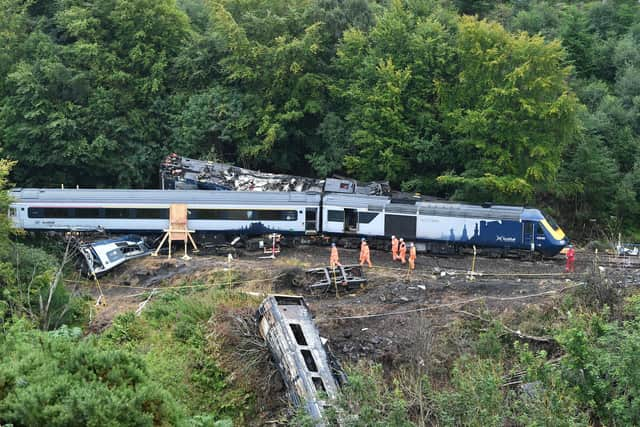Anas Sarwar demands scrapping of 40-year-old ScotRail trains after fatal Carmont crash
He told First Minister Nicola Sturgeon that allowing such trains to operate which did not meet current safety standards should be “corrected immediately” once ScotRail was taken into Scottish Government control in three weeks’ time.
Transport minister Jenny Gilruth said later a new steering group would consider taking the the trains out of service early – they are due to be retired by 2030.
Advertisement
Hide AdAdvertisement
Hide AdMr Sarwar told MSPs at First Minister’s Questions: “The train that was operating on this route was decades old. They were first introduced into service in the mid-’70s and didn’t comply with safety standards set in 1994.


"We should not have allowed unsafe trains or trains that did not meet standards to be on our railways.”
The UK Department for Transport’s Rail Accident Investigation Branch’s (RAIB) final report into the crash near Stonehaven in Aberdeenshire, in which three people were killed, said it was “more likely than not that the outcome would have been better if the train had been compliant with modern crashworthiness standards”.
The body compared the crash to the 95mph derailment of a newer Pendolino train in Cumbria in 2007, in which one passenger was killed and 30 injured.
Investigators said they did not regards “High Speed Trains” (HSTs) to be unsafe, but their report made seven recommendations for safety improvements, including stronger “lifeguard” [metal brackets] to better protect the wheels from obstacles, safer window glass, and replacing batteries in carriages that were less likely to catch fire.
Train drivers union Aslef has demanded the refurbished HSTs are withdrawn by the third anniversary of the crash in August next year.
The fleet of 25 trains operate on ScotRail’s “Inter7City” routes between Edinburgh/Glasgow and Aberdeen/Inverness.
LNER withdrew its HSTs, which operated between Aberdeen, Inverness and London, in 2019.
Advertisement
Hide AdAdvertisement
Hide AdGareth Dennis, a rail engineer who has also called for them to be taken out of service, said: “My analysis that the consequences of this derailment could have been considerably less had it involved trains with modern safety features was challenged at the time from some quarters.
"The RAIB report is explicit in confirming that ‘the outcome would have been better if the train had been compliant with modern crashworthiness standards’ and it makes several recommendations to mitigate the risks of running older trains in passenger service.
"These include potentially removing them from service where the risk of their continued operation cannot be adequately reduced.”
Manuel Cortes, general secretary of the Transport Salaried Staffs Association, said: “The RAIB report is crystal clear.
"It is devastating to think that a different train might have given us a better outcome.
“These museum pieces should have been retired a long time ago.”
However, Ms Sturgeon said the trains were “fully compliant with legal requirements to operate”.
She said the report concluded the crash was caused by infrastructure failure [a wrongly-built drain washing storm debris onto tracks], not the train.
Advertisement
Hide AdAdvertisement
Hide AdThe First Minister said a separate report, from a joint investigation by the Office of Rail and Road regulator, Police Scotland and British Transport Police, would be submitted to the procurator fiscal “later this year”.
She said: “That will allow prosecutors to consider questions of criminal prosecutions and a fatal accident inquiry.”
Transport minister Jenny Gilruth later told MSPs that a Transport Scotland-led steering group would be established “to take forward implementation of the recommendations about safety performance in accidents of older rolling stock, including HST rolling stock, on ScotRail”.
She said: “Because of their crucial role in both driving and maintaining these trains, I can give an undertaking to Scotland’s rail unions and employees that we will involve them in this important activity, alongside rail industry representatives and the safety bodies.”
Ms Gilruth said: “We will come to looking at a date in the future which we may be able to remove some of these trains from service.
"But I need to convene that steering group and I need to look forward to what that would mean for the current fleet of trains and the viability of rail travel in Scotland, recognising that we are to some extent quite reliant on the HSTs which are in operation.”
She said the group would “ensure that we deliver on the safety improvements that are needed and that our rolling stock is up to scratch and that it also provides protection and a level of security for staff, but also for passengers.”
A message from the Editor:
Thank you for reading this article. We're more reliant on your support than ever as the shift in consumer habits brought about by coronavirus impacts our advertisers.
If you haven't already, please consider supporting our trusted, fact-checked journalism by taking out a digital subscription.
Comments
Want to join the conversation? Please or to comment on this article.
